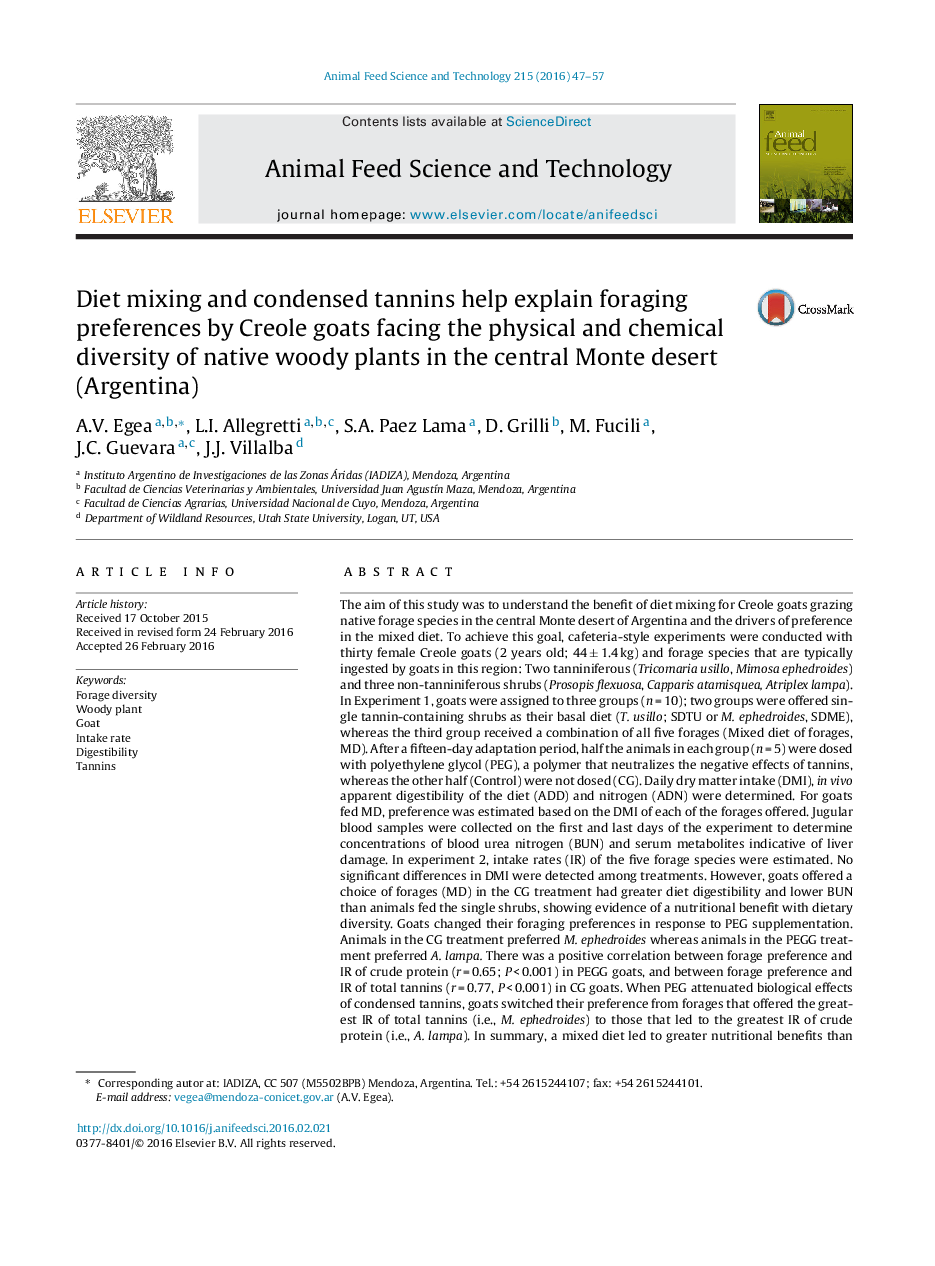| کد مقاله | کد نشریه | سال انتشار | مقاله انگلیسی | نسخه تمام متن |
|---|---|---|---|---|
| 2419259 | 1552370 | 2016 | 11 صفحه PDF | دانلود رایگان |
• We study the drivers of Creole goats’ preference for woody forage species and the nutritional benefits of dietary diversity.
• Blockade of condensed tannins induced goats to increase preference for a nitrogen-rich shrub.
• A mixed diet led greater diet digestibility than single diets, which suggest a nutritional benefit of dietary diversity.
The aim of this study was to understand the benefit of diet mixing for Creole goats grazing native forage species in the central Monte desert of Argentina and the drivers of preference in the mixed diet. To achieve this goal, cafeteria-style experiments were conducted with thirty female Creole goats (2 years old; 44 ± 1.4 kg) and forage species that are typically ingested by goats in this region: Two tanniniferous (Tricomaria usillo, Mimosa ephedroides) and three non-tanniniferous shrubs (Prosopis flexuosa, Capparis atamisquea, Atriplex lampa). In Experiment 1, goats were assigned to three groups (n = 10); two groups were offered single tannin-containing shrubs as their basal diet (T. usillo; SDTU or M. ephedroides, SDME), whereas the third group received a combination of all five forages (Mixed diet of forages, MD). After a fifteen-day adaptation period, half the animals in each group (n = 5) were dosed with polyethylene glycol (PEG), a polymer that neutralizes the negative effects of tannins, whereas the other half (Control) were not dosed (CG). Daily dry matter intake (DMI), in vivo apparent digestibility of the diet (ADD) and nitrogen (ADN) were determined. For goats fed MD, preference was estimated based on the DMI of each of the forages offered. Jugular blood samples were collected on the first and last days of the experiment to determine concentrations of blood urea nitrogen (BUN) and serum metabolites indicative of liver damage. In experiment 2, intake rates (IR) of the five forage species were estimated. No significant differences in DMI were detected among treatments. However, goats offered a choice of forages (MD) in the CG treatment had greater diet digestibility and lower BUN than animals fed the single shrubs, showing evidence of a nutritional benefit with dietary diversity. Goats changed their foraging preferences in response to PEG supplementation. Animals in the CG treatment preferred M. ephedroides whereas animals in the PEGG treatment preferred A. lampa. There was a positive correlation between forage preference and IR of crude protein (r = 0.65; P < 0.001) in PEGG goats, and between forage preference and IR of total tannins (r = 0.77, P < 0.001) in CG goats. When PEG attenuated biological effects of condensed tannins, goats switched their preference from forages that offered the greatest IR of total tannins (i.e., M. ephedroides) to those that led to the greatest IR of crude protein (i.e., A. lampa). In summary, a mixed diet led to greater nutritional benefits than single diets, which contribute to explain the diverse array of food items goats typically show when browsing in the central Monte desert of Argentina. Our results also show that CP, tannins and plant structure (which offer variable intake rates) play significant roles in goats’ foraging preferences in this environment.
Journal: Animal Feed Science and Technology - Volume 215, May 2016, Pages 47–57
